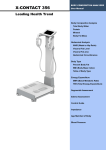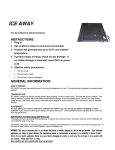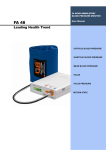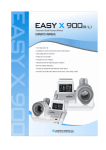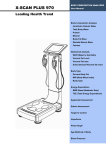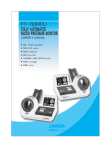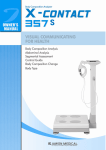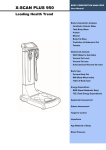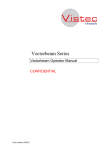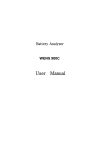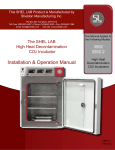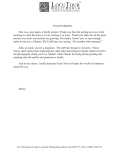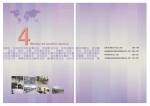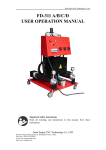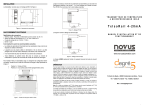Download User Manual - jawon medical
Transcript
BODY COMPOSITION ANAYZER USER MANUAL COZY-930 Leading Health Trend BODY WATER ANALYSIS Body Water Volume Intra Cellular Water Extra Cellular Water Extra Cellular Water/Total Body Water Total Body Water/Lean Body Mass Body Composition Analysis Body Water Protein Mineral Mass of body fat Soft Lean Mass Percent of Body Fat Body Mass Index Abdominal Analysis Waist to Hip Ratio Metabolic Basal Metabolic Rate Total Energy Expenditure Nutrition Protein Mineral Body cell Mass Segmental Analysis Body Fat Soft Lean Mass Extra Cellular Water/Total Body Water Impedance Reactance Phase Angle The device bears the CE label in accordance with the provisions of Medical Device Directive 93/42/EEC. THE PERSONS RESPONSIBLE FOR PLACING DEVICES ON THE EC MARKET UNDER MDD 93/42/EEC Jawon Medical Co.,Ltd. 29, Gongdan 4-ro, Jillyang-eup, Gyeongsan-si, Gyeongsangbuk-do, Korea TEL: 82-53-856-0993, FAX: 82-53-856-0995 VITAKO Sp. z o.o. UL. MALEJ SYRENKI 2 71-790 SZCZECIN, POLAND TEL: 91 8522900 / 901, FAX: 91 8522910 2 CONTENTS INTRODUCTION ·····································································································5 1. INTENDED USE ································································································5 2. WORD DEFINITIONS ·························································································5 3. CLASSIFICATION AND COMPLIANCE ···································································6 4. SAFETY PRECAUTIONS ·····················································································6 5. SAFETY SYMBOLS AND INFORMATION ·······························································8 6. Guidance for Electromagnetic compatibility(EMC) ······················································11 TERMS AND FUNCTION OF EACH PART ····································································15 1. Basic Package ··································································································15 2. Options ··········································································································16 3. Appearance of the device ·····················································································17 INSTALLATION ·······································································································20 1. Basic Installation ······························································································20 1) Cart assembly and connection of main body ························································22 2) Connecting clip electrode ················································································24 2. Power Supply ·····································································································25 3. Adjusting the height of the cart ···············································································26 4. Peripheral Device Installation ·················································································27 1) Connecting Bluetooth (Option) ··········································································27 2) Connecting Computer ·····················································································30 3) Connecting Printer (Option) ··············································································31 4) Replacing of thermal paper ·············································································32 SYSTEM SETUP ·····································································································33 1. Entering SYSTEM SETUP ···················································································33 2. Menu in SYSTEM SETUP ····················································································33 3. Selecting a Menu in SYSTEM SETUP ····································································34 4. Exiting SYSTEM SETUP······················································································34 5. Moving to SYSTEM SETUP··················································································34 6. Setup ··············································································································35 3 INITIAL SCREEN SETTING ······················································································39 MEASUREMENT AND ANALYSIS ··············································································40 1. Precautions for Measurement ··············································································40 2. Correct Posture ·································································································41 1) Posture ·······································································································41 2) How to Touch Electrodes ·················································································42 3. Measuring Procedure ························································································43 1) Basic Analysis ·······························································································43 STORAGE OF DATA USING USB MEMORY ································································46 RESULT INTERPRETATION ·····················································································47 STORAGE AND MAINTENANCE ···············································································52 ERROR & REPAIR ·································································································53 1. Kinds of Error & Repair ······················································································53 2. Error & Repair ··································································································54 AFTER SERVICE ···································································································55 1. AFTTER SERVICE ··························································································55 2. PACKING AND TRANSPORT ·············································································55 SPECIFICATION ····································································································56 WARRANTY ··········································································································59 4 INTRODUCTION We highly appreciate that you chose our company‟s product. You are kindly requested to be familiar with these directions before using this product and always keep it together with the product. In case you are not sure about any directions or problems arising while using the product, please contact our service center. We will provide you with detailed instructions. 1. INTENDED USE This device measures impedance by bioelectrical impedance analysis method and provides lots of information using measured impedance and inputted personal data (height, age, gender, weight). It shows body composition of MBF, LBM, SLM, SMM, TBW, protein mass, mineral mass, etc. and information regarding BMI, PBF, BMR, abdominal analysis, Target to control, segmental analysis, Body composition change, etc. This device can also be used for the examinee who is receiving kidney dialysis. 2. WORD DEFINITIONS To ensure safe operation and long term performance stability, it is essential that you fully understand the functions, operating and maintenance instructions by reading this manual before operating your unit. Particular attention must be paid to all warnings, cautions and notes incorporated herein. The following conventions are used throughout the manual to denote information of special emphasis. Warning "Warning" indicates important information about the presence of a hazard which may cause severe personal injury, loss of substantial property, damage if the warning is ignored. Caution "Caution" indicates important information about the presence of a hazard which may cause minor personal injury or property damage if the caution is ignored. Prohibition “Prohibition” indicates import information to signify the prohibited action. 5 Note "Notice" indicates important information in order to notify installation, operation or maintenance of this device. "Notice" is important but not hazard-related. Hazard warnings are not included here. 3. CLASSIFICATION AND COMPLIANCE 1) This device is classified as; - Class 1 type-BF against electric shock - Ordinary equipment without protection against ingress of water - Equipment not suitable for use in presence of a flammable anesthetic mixture by standard of EN 60601-1: 2006(Basic safety and essential performance of Medical Electrical Equipment) 2) This device is complied with Class A for Noise-Emission, Level B for Noise-immunity, by standard of IEC 60601-1-2:2007(Electromagnetic Compatibility Requirements). 4. SAFETY SYMBOLS AND INFORMATION The International Electrotechnical Commission (IEC) has established a set of symbols for medical electrical equipment which classifies a connection or warning of any potential hazard. The classifications and symbols are shown below. Save these instructions for your safety. Degree of protection against electric shock: TYPE BF Please observe operating instructions General warning sign General prohibition sign General mandatory action sign Caution Note Waste Electrical and Electronic Equipment (WEEE) The device could be sent back to the manufacturer for recycling or proper disposal after their useful lives. Alternatively the device shall be 6 disposed in accordance with national laws after their useful lives. "ON / OFF" key : Turn the power ON / OFF / Class II equipment This symbol is used inside system. Identifies the point where the safety ground of the system is fastened to the chassis. Do not open. This is for factory only. Alternating current Direct current Date of manufacture Manufacturer Non-ionizing radiation CE mark Serial No. Authorized representative in the European community. Keep dry For indoor use only RoHS2 7 5. SAFETY PRECAUTIONS This device is designed and manufactured with consideration of the safety of the operator and subject and also the reliability of the unit. The following warnings, precautions and notes must be observed for safety; Warning During measurement of the body composition, a microcurrent of 180μA flows through the body. Individuals who have any kind of implanted active medical devices, such as pacemakers, should not use this equipment because the microcurrent can cause malfunction in the implanted device. Warning To prevent fire hazard, use only a correctly wired (100-240VAC) outlet, and do not use a MSO(Multiple Socket Outlet) that is not in compliance with IEC 60601-1. Warning To reduce the risk of electric shock or product damage, never plug-in or plug-out with wet hands. Warning Physically disabled persons should not attempt to take measurements alone, but instead should have their caretakers assist them in using the device. Caution The unit must be operated only by, or under supervision of a qualified person with our company or our distributors. Caution If you have experienced any trouble with the unit, switch it off immediately, and contact our company or its authorized dealer for assistance. Caution If you plan to connect any device from other manufacturers electrically or mechanically to the unit, contact our company or its authorized dealer for instructions before doing so. When you connect computer or other system to the unit (RS-232C), the 8 attached systems should be those certified by IEC 950 or equivalent standards for data processing equipment. Configurations shall comply with the system standard EN 60601-1:2006. Everybody who connects additional equipment to the signal input part or signal output part configures a medical system by standard EN 60601-1:2006. If in doubt, consult the A/S department of local distributor. Caution Avoid the following environments for storage; - Where the ambient temperature falls below -25°C or exceeds 70°C. - Where the atmospheric pressure falls below 70kPa (700mbar) or exceeds 106kPa (1060mbar). - Where the humidity is over 93% non-condensing. - Where the unit is exposed to spray or splashing water. - Where the unit is exposed to dust. - Where the unit is exposed to water vapor. - Where the unit is exposed to salty atmosphere. - Where the unit is exposed to explosive gas. - Where the unit is exposed to excessive shocks or vibrations. - Where the angle of inclination of mounting surface exceeds 10 degrees. - Where the unit is exposed to direct sunlight. Caution This device needs special precautions regarding EMC and needs to be installed and put into service according to the EMC information provided in the ACCOMPANYING DOCUMENTS. Caution Cross contamination is possible because this equipment is used with bare hands and feet. Refer to the cleaning and disinfecting methods in this manual. Caution Measurements may be impaired if this device is used near televisions, microwave ovens, X-ray equipment or other devices with strong electrical fields. To prevent such interference, use the meter at a sufficient distance from such devices or turn them off. 9 Prohibition Do not disassemble or alter the device under any circumstances, as this could result in electric shock or injury as well as adversely affect the precision of measurements. This device is specified as Class 1 type BF unit under the standard EN 606011: 2006(Basic safety and essential performance of Medical Electrical Equipment). Therefore, patients must not touch or handle inner side of the system at any time. Prohibition Do not to touch signal input, signal output or other connectors, and the patient simultaneously. Prohibition The unit has previously been adjusted in the factory for optimum performance. Do not attempt to adjust switches or any other things except those specified in this manual for operation. Prohibition Never pour any liquid directly on the scale platform, as it may leak and cause internal damage.. Prohibition Never jump on the Weighing Platform, there may be a risk of stumbling and malfunction of the equipment. Note This equipment has been tested and found to comply with the limits for medical devices according to IEC 60601-1-2:2007. These limits are designed to provide reasonable protection against harmful interference in a typical medical installation. This equipment generates uses and can radiate radio frequency energy and, if not installed and used in accordance with the instructions, may cause harmful interference to other devices in the vicinity. However, there is no guarantee that interference will not occur in a particular installation. If this equipment does cause harmful interference to other devices, which can be 10 determined by turning the equipment off and on, the user is encouraged to try to correct the interference by one or more of the following measures: - Reorient or relocate the receiving device. - Increase the separation between the equipment. - Connect the equipment into an outlet on a circuit different from that to which the other device(s) are connected. - Consult the manufacturer or field service technician for help. Note Place the Weighing Platform on a level and stable surface. If the equipment is used when the Weighing Platform is unstable because not all feet are on the surface, there may be a risk of stumbling or inaccurate measurement. Note Note that portable and mobile RF communications equipment can affect MEDICAL ELECTRICAL EQUIPMENT. Note Consult a physician or a trained health professional for interpretation of measurement results. Note In case of patients who have certain diseases, the estimates might be different. Note Incorrect operation or failure of user to maintain the unit spares the manufacturer or his agent of the responsibility for system‟s non-compliance with specifications or responsibility for any damage or injury. This manual is made for informational purposes and this manual and product are not meant to be a substitute for the advice provided by your own physician or other medical expert. You should not use the information contained in the product for diagnosis or treatment of health problems or prescription of medication by yourself. If you have or suspect that you have a medical problem, consult with your physician promptly. 11 Defective units or accessories must be packed in the replacement cartons to be shipped off from you to our company. Shipping and insurance costs for return of defective unit must be prepaid by the users. 6. Guidance for Electromagnetic compatibility (EMC) Details about the electromagnetic compatibility (EMC) of the COZY-930 are given below. Before using the COZY-930, be sure to read and understand the following information. 1) Guidance and manufacturer’s declaration – electromagnetic emissions The COZY-930 is intended for use in the electromagnetic environment specified below. The customer or the user of the COZY-930 should assure that it is used in such an environment. Emissions test Compliance Electromagnetic environment – guidance The COZY-930 uses RF energy only for its RF emissions CISPR 11 Group 1 internal function. Therefore, its RF emissions are very low and are not likely to cause any interference in nearby electronic equipment. RF emissions CISPR 11 Class B Harmonic emissions The Class A COZY-930 establishments, is suitable for including use in all domestic IEC 61000-3-2 establishments and those directly connected to Voltage the public low-voltage power supply network that fluctuations/ flicker emissions Compliance supplies buildings used for domestic purposes. IEC 61000-3-3 12 2) Guidance and manufacturer’s declaration – electromagnetic immunity The COZY-930 is intended for use in the electromagnetic environment specified below. The customer or the user of the COZY-930 should assure that it is used in such an environment. Immunity test D) ±6kV: Contact ±6kV: Contact ceramic tile. If floors are covered with ±8kV: Air synthetic IEC ±8kV: Air 61000-4-2 Power transition/bur lines supply lines st ±1kV: ±1kV: IEC 61000-4-4 Input/output lines Input/output lines ±1 kV differential ±1 kV differential mode mode IEC 61000-45 Voltage drops, dips, and fluctuations of input power supply line IEC 61000-4-11 ±2 kV common ±2 kV common mode mode <5 % UT (>95 % dip in UT) for 0,5 cycle 40 % UT (60 % dip in UT) for 5 cycles 70 % UT (30 % dip in UT) for 25 cycles <5 % UT (>95 % dip in UT) for 5 sec <5 % UT (>95 % dip in UT) for 0,5 cycle 40 % UT (60 % dip in UT) for 5 cycles 70 % UT (30 % dip in UT) for 25 cycles <5 % UT (>95 % dip in UT) for 5 sec Magnetic field material, the relative Mains power quality should be that of a typical commercial or hospital environment. Mains power quality should be that of a typical commercial or hospital environment. Mains power quality should be that of a typical commercial or hospital environment. If the user of the COZY930 requires continued operation during power mains interruptions, it is recommended that the COZY-930 be powered from an uninterruptible power supply or a battery. Power frequency magnetic fields should of commercial frequency guidance Floors should be wood, concrete or humidity should be at least 30 %. Electrical fast ±2kV: Power supply ±2kV: Surge environment- Compliance level Electrostatic discharge(ES Electromagnetic IEC 60601 test level 3 A/m be at levels characteristic of a typical 3 A/m location in a typical commercial or hospital (50/60Hz) environment. IEC 61000-4-8 Note UT is the a.c. mains voltage prior to application of the test level. 13 3) Guidance and manufacturer’s declaration – electromagnetic immunity 2 The COZY-930 is intended for use in the electromagnetic environment specified below. The customer or the user of the COZY-930 should assure that it is used in such an environment. Immunity test IEC 60601 test Compliance Electromagnetic level level environment- guidance Portable and mobile RF communications equipment should be used no closer to any part of the COZY-930, including cables, than the recommended distance equation calculated applicable separation from the to the frequency of the transmitter. Recommended separation distance Conducted RF 3 Vrms IEC 61000-4-6 150 kHz to 80 MHz Radiated RF 3 V/m IEC 61000-4-3 80 MHz to 2,5 GHz d =1.2 3 Vrms 3 V/m d =1.2 80 MHz to 900 MHz d =2.3 900 MHz to 2,5 GHz where P is the maximum output power rating of the transmitter in watts (W) according to the transmitter manufacturer and d is the recommended separation distance in meters (m). Field strengths from fixed RF transmitters, as determined by an electromagnetic site survey,a should be less than the compliance level in each frequency range.b Interference may occur in the vicinity of equipment marked with the following symbol: 14 Note 1. At 80 MHz and 900 MHz, the higher frequency range applies. 2 These guidelines may not apply in all situations. Electromagnetic propagation is affected by absorption and reflection from structures, objects and people. a Field strengths from fixed transmitters, such as base stations for radio (cellular/cordless) telephones and land mobile radios, amateur radio, AM and FM radio broadcast and TV broadcast cannot be predicted theoretically with accuracy. To assess the electromagnetic environment due to fixed RF transmitters, an electromagnetic site survey should be considered. If the measured field strength in the location in which the COZY-930 is used exceeds the applicable RF compliance level above, the COZY-930 should be observed to verify normal operation. If abnormal performance is observed, additional measures may be necessary, such as reorienting or relocating the COZY-930. b Over the frequency range 150 kHz to 80 MHz, field strengths should be less than 3 V/m. 4) Recommended separation distances between portable and mobile RF communications equipment and the COZY-930 The COZY-930 is intended for use in an electromagnetic environment in which radiated RF disturbances are controlled. The customer or the user of the COZY-930 can help prevent electromagnetic interference by maintaining a minimum distance between portable and mobile RF communications equipment (transmitters) and the COZY-930 as recommended below, according to the maximum output power of the communications equipment. Rated maximum Separation distance according to frequency of transmitter m output power of transmitter W 150 kHz to 80 MHz 80 MHz to 900 MHz 900 MHz to 2,5 GHz d =1.2 d =1.2 d =1.2 0.01 0.12 0.12 0.23 0.1 0.38 0.38 0.73 1 1.2 1.2 2.3 10 3.8 3.8 7.3 100 12 12 23 For transmitters rated at a maximum output power not listed above, the recommended separation distance d in meters (m) can be estimated using the equation applicable to the frequency of the transmitter, where P is the maximum output power rating of the transmitter in watts (W) according to the transmitter manufacturer. Note 1. At 80 MHz and 900 MHz, the separation distance for the higher frequency range applies. 2. These guidelines may not apply in all situations. Electromagnetic propagation is affected by absorption and reflection from structures, objects and people. 15 TERMS AND FUNCTION OF EACH PART 1. Basic Package ① Main body ② Electrode cable 4ea / Clip electrode 4ea ③ User manual ④ Data management program ⑤ USB cable ⑥ Power Cable/Adapter ⑦ Thermal printer paper ⑧ Roller ⑨ Case ⑩ Electrode Gel ⑪ Exclusive cart X4 X4 ① Main body ② Electrode cable 4ea/Clip electrode 4ea ③ User manual ④ Data management ⑤ USB cable program ⑥ Power cable/Adapter ⑧ Roller ⑨ Case ⑦ Thermal printer paper ⑩ Electrode gel ⑪ Exclusive cart ※ The model or specification are subject to change according to the market demand. 16 2. Option 1) Professional health counseling software (CD) This program helps managing body composition easily and systematically. Also it interprets the measurement results in particular and shows the core items needed to control body composition. 2) A4 Result Sheet The results are indicated systematically and anyone can easily understand the results. 3) USB memory It is possible to check the result on PC through USB memory. USB memory Bluetooth 4) Bluetooth It allows to do wireless communicate with a PC or mobile device. ※ Model or specification of accessories can be changed according to market supply and demand. 17 3. Appearance of the device 1) Front Part Wide Color LCD Operation Button Thermal Printer Start/Stop Button ▪ Wide Color LCD: The touch screen displays the inserted data, procedure and results. ▪ Operation Button: It is for choosing or handling items by turning it right or left. ▪ Start/Stop Button: It is for starting and stopping the machine. ▪ Thermal Printer: It prints the results on the thermal printer paper. 18 2) Side Part Hand Electrode Foot Electrode Connection Port Connection Port ▪ Hand Electrode Connection Port: Port for connecting electrode cables of right and left hands ▪ Foot Electrode Connection Port: Port for connecting electrode cables of right and left feet 3) Rear Part Power Switch Power Entrance USB(A) Port RS-232C Port USB(B) Port ▪ Power Switch: Switching on or off ▪ Power Entrance: Connecting adapter ▪ USB (B) Port: Terminal for connecting the user‟s computer to the device ▪ USB (A) Port: Terminal for connecting the printer(option) to the device ▪ RS-232C Port: Terminal for connecting to the external device 19 4) Cart Clip Electrode hanger Clip Electrode Handle Electrode Cable Cabinet Cart Wheel ▪ Clip Electrode hanger: Clip Electrodes are hanging on the hanger. ▪ Clip Electrode: It measures Impedance by being fixed to wrists and ankles as a clip form. ▪ Electrode Cable: It connects clip electrodes to main body. ▪ Cabinet: It keeps charts, cables and etc. ▪ Handle: It makes the movement easy. ▪ Cart Wheel: It makes the movement easy by turning 360°. 20 INSTALLATION 1. Basic Installation 1) Cart assembly and connection of main body (1) Cart assembly package Note (+)Driver is not included in the package so prepare it personally. ① Cart main body 1ea ② M4 bolt(m size) 4ea 21 ③ M5 bolt 10ea ④ Cart wheel 5ea (2) Cart wheel assembly Connect the 5 cart wheels to the cart main body as shown in the picture. Fix the connected cart main body and wheels each other with 10 M5 bolts by using (+)driver like the picture above. 22 (3) Checking the horizontality of clip electrode hanger The clip electrode hanger should be at a level like the picture above. If not, adjust the angle of the clip electrode hanger by turning the control knob. 23 (4) Fixing the main head to the cart Fix the main head with M4 bolts by using (+) driver like the picture. 24 2) Connecting clip electrode ① Put the plug of the electrode cable to the socket of clip like below. Note 1. The cables are separated into 4 parts(Left Arm/ Right Arm/ Left Leg/ Right Leg) so connect them to the correct ports. 2. Hand and foot clip electrodes are not necessary to be used separately. ② Connect 4 cables to the clip electrode ports at the side of the main body like below. 25 2. Power Supply Connect the power cable to the 'ADAPTER INPUT' placed on the lower back panel of the device. Connect the cable. Turn on the power switch placed next to Power input, then after moment initial screen animation is displayed automatically. Caution 1. Before connecting a peripheral device to this device, the power should be turned off. Otherwise this device can malfunction or be damaged due to electric shock. 2. Power shouldn‟t be supplied to the peripheral devices to ensure the safe operation and durable performance. 3. This device should be powered with the adapter and cable supplied only from our company. 26 3. Adjusting the height of the cart Adjust the height of the cart by using the adjusting screw on the back side of the cart so that the electrode cable cannot touch the floor. Turn the adjusting screw to the left to make the screw loose and adjust the height of the cart and turn the screw to the right to make it tight. 27 4. Peripheral Device Installation 1) Connecting Bluetooth (Option) This device can be connected with peripheral devices of Jawon Medical. Connect optional devices that Jawon provides (Bluetooth and etc) to the RS-232C port on the back side of the device by using the RS-232C cable that Jawon also provides. When choosing a Bluetooth, connect the Bluetooth that Jawon provides to the Bluetooth port on the backside of the device. In this case, users can check and manage the result data on the exclusive mobile device app via Bluetooth connection. ① Components for Bluetooth Bluetooth Antenna Bracket Cable ② Unscrew the (+) bolts (2EA) on the back side of the body with a (+) driver. Keep the separate (+) bolts (2EA) to assemble a bracket and cable later as show in the picture below. 28 ③ Connect the antenna to the Bluetooth. - Connect the antenna to the Bluetooth. Turn the antenna at a right angle to the Bluetooth as shown in the picture. Connect the cable for the connection with the main body to the opposite side of the antenna. Screw the fixing bolt of the Bluetooth with a (-) driver to fix the cable. ④ Switch on the Bluetooth as show in the picture below. 29 ⑤ Attach the provided bracket to the Bluetooth and fix them on the back side of the device with a (+) plus driver. Bracket Combination ⑥ Connect the unconnected opposite part of the cable to the „RS-232C‟ port on the back side of the device and turn on the device. 30 2) Connecting Computer Connect the “USB(B)” port placed on the rear panel of this device to the USB port in computer with USB cable. Note 1. In order to save, search, and retrieve subject‟s data, the device should be connected to PC in which Body Pass Plus is installed. The result sheet can be printed from the printer connected to the PC. 2. Professional consulting software, Easy Body Plus (option) easily assesses and explains body composition analysis. This program helps managing body composition easily and systematically. It can help the measurer to analyze his/her body composition at a glance. 3. For the installation of Body Pass Plus and Easy Body Plus, refer to its User's manual. 31 3) Connecting Printer (Option) ① Connecting the device, computer, and the printer Connect a computer to the “USB(B)” jack placed on the rear panel of the device with USB cables. Connect the printer to the computer with printer cable. The result sheet can be printed out from the printer. ② Connecting the device and the printer directly In order to see the measurement result with A4 printer, connect the A4 printer offered with this device to the “USB(A)” port placed on the rear panel of this device with USB cable and then print the result on A4 sheet 32 4) Replacing of thermal paper Replace thermal paper while the power is on. ① Push the side button while pulling down the lower button to open the cover. ② Insert the roller in the middle of the thermal paper. ③ Insert the thermal paper with the roller in the grooves as shown in the picture. ④ Slightly take out the edge of the thermal paper. ⑤ Cover the printer. ⑥ Thermal paper will be printed out and it automatically cuts out. 4-1) Solution for thermal printer jam ① Open the cover placed lower part as show in the picture. ② Push the button for jam inside the printer. ③ Remove the jammed paper from the printer. 33 SYSTEM SETUP ㅅ;ㅅ, SYSTEM SETUP allows users to change the setting of operational parameters. Note Setup contents of this device are subject to change for efficient improvement. 1. Entering ‘SYSTEM SETUP’ Press the left upper edge of the initial screen for 3~4 seconds. After it, when a keypad image appears, press 1 2 3 4 in order. Then it will be changed to „SYSTEM SETUP‟ mode. 2. Menu in SYSTEM SETUP Menu items are displayed. The function of each icon is as follows. 1. DATE/TIME 2. VOLUME 1. 3. PRINT 4. PRINT POSITION 5. 5. DATE TYPE 6. THERMAL PRINT 9. 7. LANGUAGE 8. QR CODE DOMAIN 9. COMMUNICATION 10. HEIGHTMETER 34 2. 3. 4. 6. 7. 8. 10. 3. Selecting a Menu in SYSTEM SETUP Select menu according to one‟s desire, and confirm changes using「SET」button. 4. Exiting SYSTEM SETUP Press 「CLOSE」button on 'SYSTEM SETUP' phase, then back to initial view of the analyzer. 5. Moving to SYSTEM SETUP Press「CLOSE」button on the menu view, then program is returned to 'SYSTEM SETUP' phase. 35 6. Setup < DATE / TIME > It sets date and time (year, month, day, hour, and minute). - Select (DATE / TIME) on SYSTEM SETUP screen and press SET button on touch pad. - Pre-set: The date and time of the device released from the manufacturer's factory. - Set YEAR by pressing „▼, ▲‟ on touch pad. - Press „MONTH‟ and set Month in the same way to set YEAR. - Choose DAY, HOUR, MIN and Set correct date and time in the same way. - Press „SET‟ on touch pad to save the change. - Return to SYSTEM SETUP screen by pressing „CLOSE‟ on touch pad. 1. If „SET‟ button is pressed before finishing setup of date and time, the date Note and time inputted at that time is saved and SYSTEM SETUP screen appears. To cancel any changes attempted, press „CLOSE‟ then this device saves the previous date and time and SYSTEM SETUP screen appears. 2. When software is used in data management, measured date is automatically saved as the date set in this device. Therefore the date and time set in this device should be checked before use. < VOLUME > It adjusts the volume of voice guidance. - Select (VOLUME) on SYSTEM SETUP screen with „▼,▲‟ button and press „SET‟ on touch pad. - Pre-set: 3 - Range: 0 ~ 9 - Adjust volume with „▼,▲‟ button on touch pad. - Press „SET‟ on touch pad to save selected value. - Return to SYSTEM SETUP screen by pressing „CLOSE‟ on touch pad. 36 <PRINT-Option> Choose a printing mode among AUTO, MANUAL or OFF. - Pre-set: OFF - Select „ ‟ (PRINT) to enter the menu. - Choose one button on touch pad. - Press „SET‟ button on touch pad to save it. - Return to SYSTEM SETUP screen by pressing „CLOSE‟ button on touch pad. <PRINT POSITION> It adjusts the printing position in the direction of U-D (up- down) and L-R (left-right) to fit to the pre-formatted result sheet. - Range: 99 for U-D and 99 for L-R - Select „ ‟ (PRINT POSITION) to enter the menu. - Press the arrows which are surrounding the quadrangle as much as adjust. Every single press moves print position by about 0.2 mm. - Choose U-D by pressing „▼,▲‟ on touch pad. Choose L-R by pressing „▶, ◀‟ on touch pad. - Press „SET‟ button on touch pad to save it. - Return to SYSTEM SETUP screen by pressing „CLOSE‟ button on touch pad. Note L-R (left-right): - is moving to the left and + is moving to the right. U-D (up-down): - is moving up and + is moving down. 37 <DATE TYPE> This is to set the format of the date. - Pre-set: YY-MM-DD - Select „ ‟ (DATE TYPE) to enter the menu. - Choose the format on touch pad. - Press „SET‟ button on touch pad to save it. - Return to SYSTEM SETUP screen by pressing „CLOSE‟ button on touch pad. <THERMAL PRINT> It selects the printing mode of thermal printer. - Pre-set: ON/OFF-ON - Select „ ‟ (THERMAL PRINT) to enter the menu. - ON/OFF: Choose ON/OFF on touch pad. Choose „AUTO‟ or „MANUAL‟ or „OFF‟ on touch pad. - Press „SET‟ button on touch pad to save it. - Return to SYSTEM SETUP screen by pressing „CLOSE‟ button on touch pad. <LANGUAGE> You can select one of the languages of Korean, English and Japanese. - Pre-set: ENGLISH - Choose ‘ ’ (LANGUAGE) to enter the menu. - Select one of the languages you want to set. - Press „SET‟ button on touch pad to save it. - Return to SYSTEM SETUP screen by pressing „CLOSE‟ button on touch pad. 38 < QR CODE DOMAIN > This is for setting QR code domain. - Select „ ‟ to enter the menu. - Enter a domain address or IP you want on the touch pad. A maximum 20-digit number can be entered for the domain address. - Press „DONE‟ button to save the data and return to the initial screen. Note Once you scan QR code after a measurement, the data will be stored in the server of the saved domain address. If the domain address is not set, the data will be stored in the server of Jawon Medical „m.jawon.com‟. You can search the measurement data by creating an ID and PW. <Communication> Select the connecting method. 'CABLE' is for USB cable and 'WIRELESS' is for wireless communication. - Select (COMMUNICATION) on SYSTEM SETUP screen and press „SET‟ button on touch pad. - Preset: CABLE - Choose CABLE or WIRELESS on touch pad. - Press „SET‟ button on touch pad to save it. - Return to SYSTEM SETUP screen by pressing „CLOSE‟ button on touch pad. < Heightmeter> Select the connecting heightmeter. - Select (HEIGHTMETER) on SYSTEM SETUP screen and press „SET‟ button on touch pad. - Preset: OFF - Choose ON or OFF on touch pad. - Press „SET‟ button on touch pad to save it. - Return to SYSTEM SETUP screen by pressing „CLOSE‟ button on touch pad. 39 INITIAL SCREEN SETTING Once turning on the device, you can see the screen same as right picture. 1. ID search Once you press ‘START’ button on the initial screen, the screen will be changed as follows. Input an ID you would search on the ID blank and press ‘ ’ button. Then ‘Information Search’ and ‘Result Search’ buttons will appear on the screen. If you press ‘Result Search’, you can see the results for the ID and print the results. Note „Information Search‟ button has a function to import the input information of the saved ID. 2. INDEX search In case of not using ID, INDEX search can be used on the left upper side of the screen. Press ID part on the screen and enter an index number and press „ can search or see the results and print them. 40 ‟ button. Then you MEASUREMENT AND ANALYSIS ㅅ;ㅅ, 1. Precaution for measurement The reliability of the results can be assessed by its accuracy. The "Accuracy" of the device is determined by comparing the actual body composition and the results from Body Composition Analyzer. The "Reproducibility" is determined when the device gives the identical results under the same conditions. In order to maintain the accuracy of the results, the following guidelines should be kept. ① Water volume increases after a meal. Therefore, measure on an empty stomach. - Measure 3 ~ 4 hours after a meal. - Avoid beverages containing caffeine or beverages functioning as diuretics 4 hours before measurement. - Drink 2 cups of water 2 hours before the measurement. ② Before measurement, the subject should be in a stable condition. - Measure 3 ~ 4 hours after a bath, a sauna, exercise or activity that sweats a lot. - Or measure before these actions. ③ Avoid drinking alcohol 24 hours before the measurement ④ Wear clothes as light as possible. ⑤ Once the subject is on the scale, avoid sudden movement from sitting to standing position. Body fluid goes down to the lower body and affects the results. Thus subjects should be measured after maintaining standing position for 5 minutes. ⑥ Clean both the electrodes and measuring body parts. ⑦ Changes in room temperature may affect the results. Measurement should be done in a temperature around 20 °C. ⑧ Body composition and weight varies even during a day. Therefore, the measurement should be performed at the same time every day. For a person who stands for a long period of time during the day, it is advised to measure in the morning. ⑨ Go to bathroom before measurement. ⑩ Maintain correct position and posture during the measurement. In order to keep one's health and the balance of body composition, check the changes of body composition through continuous analysis and compare the results. Make sure that the body composition should are measured under the same physical and environmental conditions. If the condition before the measurement such as volume of a meal, meal time, and activities (exercise, sauna, drinking lots of beverage, urination, etc.) are kept same, the reproducibility of a device is obtained. Therefore, the data can be used to evaluate the change of body composition. 41 2. Correct Posture 1) Posture Keep correct posture for accurate results. Keep the stable posture for 10~15 minutes before measurement to measure exactly. ① A subject should be measured after maintaining supine position for 5 minutes. ② Spread both arms 30° aside from the trunk. ③ Set both legs apart as much as shoulders and make sure that they are not touched. 2) How to Touch Electrodes Maintaining the right posture during the measurement is essential to achieve reliable results. It‟s important to 42 maintain examinee‟s posture for 10-15 minutes so that impedance can be measured accurately. • Clean wrists, ankles and electrodes with wet tissue. • Wear the clamp electrodes on wrists and ankles. Spread arms and legs naturally as shown in the picture below. Caution 1. Make sure that the subject‟s body is not touching other people or conductible materials. 2. Make sure arms do not touch the trunk of the body. Spread arms to around 15 degree angle away from the trunk, and make sure legs do not touch each other. 2. Keep stable contact with every electrode. If electrode is not properly contacted, it may cause the cease of the measurement or decrease reliability of data during measurement. 43 3. Measuring Procedure 1) Basic Analysis ① Choose a mode by using jog shuttle or touch screen. User can measure one among body water, body composition, impedance and ALL. ② Press START button and the personal information window pops up. ③ Input personal information. Input personal information in order. Input ID, weight, height, age and gender and choose the state of dialysis. Confirm the inputted date then, press Next button. If the inputted information is wrong, correct it or press Reset button to revise all. ▪ Choosing a mode - Choose the mode and press OK. - Press START button and the personal information window pops up. ▪ Input ID - Input ID. - ID can be made up to 20 characters including English, number and a space. - Once you complete the input, press WEIGHT button. Note 1. Input ID and press „ID SEARCH‟ to call or search the ID saved in database. Search Data: Display the result with the searched ID. Search Resolving: The previous measured data of weight, height, age and gender is automatically inputted with the searched ID. The saved data can be changed. 2. When transmit the member information from Body Pass Plus to the device, ID USAGES screen will appear. In this case, you can not modify personal information such as height, age and gender at the device. Modify the personal information on the program and transmit the member information to the device again. ▪ Input weight - Input weight by using LCD touch pad. - The possible input range: 10 ~ 270 kg - Press HEIGHT button. ▪ Input height 44 - Input height by using LCD touch pad. - The possible input range: 50 ~ 220 cm - Press AGE button. ▪ Input age - Input age by using LCD touch pad. - The possible input range: 1~99yrs - Press GENDER button. ▪ Select gender - Select gender by using LCD touch pad. ▪ Select state of dialysis - Select state of dialysis by using LCD touch pad. (before dialysis, during dialysis, after dialysis) Note BCA (Body composition analysis) could be used as a complementary method for assessing nutritional status of HD(hemodialysis) and CAPD(continuous ambulatory peritoneal dialysis) patients as body weight or BMI measurements do not reflect fat, muscle masses, and visceral fat ratios in these patients. Use this equipment as directed by an attending physician. ④ Measurement Measurement starts after input. Check whether clip electrodes are accurately equipped. Do not move or talk during measurement. Note 1. When the measurement is incorrect, - The message, “Impedance is out of the range.” appears on the screen. - If the measurement fails three times in a row, the message appears as below. "The measurement can not complete due to the continuous errors. - Refer to „Solution‟. ⑤ Result screen After measurement is completed, the result for the selected items is displayed on the screen. 45 ⑥ Move to the result screen Press Control Dial in the middle of the device or „MENU Folder‟ button in the upper right corner of the touch screen to move to another screen. Articles are displayed on the right side of the screen as shown in the picture. View Graph, body water, body composition, View All and View Impedance are available. Select an article and move to the corresponding screen. ⑦ Scanning QR code - Press the „QR code‟ on the device screen to enlarge the icon and scan the „QR code‟ with a mobile device to save the data in the server. After scanning the „QR code‟, you can check the measurement data with your mobile device and manage it at will from the server in which it is saved.. Note 1. Scan the QR code with a QR code reader in a smart mobile device. 2. The data saved in the server could be damaged or lost due to a problem with the server. ⑧ Restarting - Once the result is displayed on the display, it can be printed out in pre-printed result sheet. - After confirming the analyzed result, press „Initial view‟ to restart. - The device returns to the initial screen after one minute. 46 STORAGE OF DATA USING USB MEMORY 1. Storage of data ① Insert USB memory stick into USB(A) jack placed on the back side of the device. ② The following message appears. „Do you want to write data to USB memory stick?‟ on initial screen. Press „YES‟ to send data to USB memory. ③ Transmitting message will be displayed on the screen. When transmission is complete, the message „The data writing was completed‟ will be shown. Press CLOSE to complete the saving process. 2. Data Deletion Press the upper left corner for 5 seconds on initial screen. Password window will appear. Press „1111‟ on the password window. The following message appears. “Do you want to delete all data?‟ If you want to delete the data, press YES to delete, otherwise press NO. When deleting the data, the message „All data were deleted‟ will appear. Press „Close‟ to return to initial screen. (Deleted data can not be restored) 47 RESULT INTERPRETATION This product shows not only result of analysis but also detailed data of body water, impedance and body parts. Here's the explanation and the criteria of the printed results. Personal Data The subject's name / ID, date, height, weight, age and gender are indicated on the result sheet. Body Composition Analysis The body composition analysis is indicated in the ratio based on the subject‟s weight. ① Weight: It is the sum of total body water, mineral, protein, and body fat in the table. ② M.B.F. (Mass of Body Fat): It is calculated by subtracting lean body mass from weight. ③ L.B.M. (Lean Body Mass): It is calculated by subtracting mass of body fat from body weight. Lean body mass consists of fat free mass of body such as muscle, organs, blood and water. ④ S.L.M.: (Soft Lean Mass): It consists of body water and protein. It maintains body functions composing of visceral muscle such as skeletal muscle, heart and stomach. ⑤ Mineral: It composes of bone and electrolyte. ⑥ Protein: this is a major element that composes soft lean mass together with body water. Assessment of Under, Optimal, and Over in the table is assessed by the optimal range based on standard weight of the subject. Body Water Analysis ⑦ T.B.W. (Total Body Water): It consists of intra-cellular and extra-cellular water. For healthy adults, body water is 45 ~ 65% of body weight even though it varies between persons. ⑧ Intra-cellular water: Quantity of water existing inside cells. ⑨ Extra-cellular water: Quantity of water existing outside cells. ⑩ Edema: Balance of body water is assessed with ratio between extra-cellular water and total body water. ⑪ T.B.W./ L.B.M.: Ratio of total body water to L.B.M Assessment of E.C.W./T.B.W. Edema is unbalance state of intra and extra cellular water. Edema can be increased by salty food, malnutrition, postpartum, exercise, temporary fatigue etc. It is divided into 3 steps; Optimal, Borderline, Over. 48 Body Status Body Status is displayed in a bar graph as shown in the picture. It is very convenient to recognize what to do; Increase muscle, Decrease fat, Keep current status, etc. 1) Percent of Body Fat [%]: for Adults low fat normal overweight obese severe obese Male less than 15 15 ~ <20 20 ~ <25 25 ~ <30 over 30 Female less than 20 20 ~ <30 30 ~ <35 35 ~ <40 over 40 2) Body Mass Index (kg/m2): for Adults *EAST ASIA thin normal overweight obese < 18.5 18.5 ~ ≤ 23 23 ~ ≤ 25 over 25 thin normal overweight obese < 18.5 18.5 ~ ≤ 25 25 ~ ≤ 30 over 30 * EU and etc. Abdominal Analysis Abdominal fatness is divided into subcutaneous type and visceral type. When it comes to body fat, experts say that not only the amount of fat is important but also its distribution. If visceral fat area is over 100 cm2, it is classified as "visceral obesity" regardless of P.B.F., W.H.R. or Body weight. Waist-to-hip ratio (W.H.R.) shows the distribution of fat stored in one‟s abdomen and hip. It is simple but useful in assessing fat distribution. Body fat is stored in two distinct ways. They are often categorized into and called 'apple' and 'pear' type. Apple type shows bigger girth of waist than hip and pear type has bigger girth of hip than waist. If body fat in abdomen increases, the risk to cardiovascular diseases, diabetes, etc. becomes higher. 49 1) W.H.R. (Waist to Hip Ratio) W.H.R. is calculated by dividing waist girth by hip girth. When W.H.R. is below 0.9 (male) / 0.85 (female), the risk of visceral obesity is low. 2) Visceral Fat Level: The degree of visceral obesity is displayed in a level. ▪ Level 1~ 4 corresponds to subcutaneous fat type ▪ Level 5~ 8 corresponds to balanced type that subcutaneous and visceral fat is balanced. ▪ Level 9~10 corresponds to borderline type. If subjects maintain current lifestyle, they will proceed to visceral fat type. ▪ Level 11~15 corresponds to visceral fat typeⅠ. ▪ Level 16~20 corresponds to visceral fat typeⅡ. 3) V.F.A. (Visceral Fat Area): The optimal range is 50 ~ 100 cm2 (male), 40 ~ 80 cm2 (female). 4) V.F.M.(Visceral Fat Mass): V.F.M. is indicated in „kg‟ unit. Target to Control It shows the mass of body fat, soft lean mass and weight to be controlled. This control is divided into 2 steps by comparing current state with the values based on standard weight. At the first step of control, target is to reach the minimum (When assessed „Under‟) or maximum (When assessed „Over‟) value of optimal range. At the second step, target is to come to the mean value of optimal range. Body Composition Change Check to change of body fat, soft lean mass and weight for 8 times. Segmental Analysis Soft lean mass and mass of body fat of five body parts (left and right arms, left and right legs, and trunk) are analyzed. Body Type Body type is determined by B.M.I and P.B.F. Body type is classified into Low fat / Low fat Muscular / Over Weight Muscular / Athletic / Thin / Standard / Over Weight / Borderline / Low Muscular / Over-fat / Thin Fat / ObeseⅠ/ ObeseⅡ/ Obese Ⅲ. B.C.M.(Body Cell Mass) It consists of intra cellular water and protein. 50 Phase angle Phase angle is an indicator of cellular health and integrity. A low phase angle is consistent with an inability of cells to store energy and an indication of breakdown in the selective permeability of cellular membranes. A high phase angle is consistent with large quantities of intact, healthy cell membranes and body cell mass. Phase angle for adults range from 2~20 degrees, with normal values of 6 to 8 degrees. Energy Expenditure 1) B.M.R. (Basal Metabolic Rate) B.M.R. refers to the calories required to maintain human body's basic function such as movement of heart, brain, neural transmission, regulating body temperature and so on. B.M.R. is in proportion to S.L.M. because body fat stores energy while muscle consumes energy. Therefore, even if the weight is same between persons, the person with more muscle has greater B.M.R. 2) T.E.E. (Total Energy Expenditure) It is the sum of basal metabolic rate and calories needed for daily activity. Generally it is calculated by multiplying B.M.R. by PAL (Physical Activity Level). A.M.B.(Age Matched of Body) It is the estimated physical age of the subject considering body composition analysis result, gender, and biological age. This is calculated by comparing the optimal body composition based on the gender and biological age of the subject with the actual analyzed body composition. It can be used to evaluate the subject‟s health and body development. Study 1) Impedance & Reactance It indicates the segmental impedance and reactance of five body parts (left and right arms, left and right legs, and trunk) corresponding to each frequency (1~ 1000 kHz). 2) Phase angle Phase angle is an indicator of cellular health and integrity. A low phase angle is consistent with an inability of cells to store energy and an indication of breakdown in the selective permeability of cellular membranes. A high phase angle is consistent with large quantities of intact, healthy cell membranes and body cell mass. Phase angle for adults range from 2~20 degrees, with normal values of 6 to 8 degrees. 51 Blood Pressure When the blood pressure monitor supplied from Jawon Medical Co., LTD is connected to the device, blood pressure can be measured and the result can be printed out. Systolic blood pressure, diastolic blood pressure, and pulse are printed on result sheet. It helps to recognize hypertension assessment related to obesity. QR code Scan the QR code with a smart phone to see the result on the website. 52 STORAGE & MAINTENANCE 1) Pay attention to the allowable value of electric current. 2) Avoid direct sunlight, humidity, dust, thick oil and salty environment or extreme changes in temperature. 3) Do not install or store the device in a place where any chemicals or gas are stored. 4) Do not use the device in any unstable, vibrating, or impact-giving area. 5) Connect the earth placed on the backside of this device to terminal plate to prevent any electric shock from leaking current or a potential difference. 6) Do not put or drop anything on the device and avoid strong impact. 7) Do not disassemble or remodel the device. 8) If this unit has not been used for a long time, use this after confirming with an expert if all function and appearance are in good condition. 9) Do not splash any fluid on this device or insert any foreign substances. 10) In case of inserting foreign substances or exposing to particular environment, this device must be examined by an expert before use. 11) Use the power cable, plug, and fuse that are offered by our company. At this time, confirm the covering of cable, the state of plug connection, and other check points. • RS 232C cable • USB port • Adapter 12) When pulling out the power cable, turn off the power switch first and then pull the plug out. 13) Storage ambient: Temperature -25 ~ 70 °C, Humidity lower than 93 % (non condensing) 14) Operation ambient: Temperature 5 ~ 40 °C, Humidity 15 ~ 93 % (non condensing) 15) Do not store or use this device under 70 kPa (700 mbar) or over 106 kPa (1060 mbar) of atmospheric pressure. 16) Cleaning & Disinfection ① Cleaning: Use a soft gauze cloth with volatile liquid like alcohol (Ethyl or Isopropyl alcohol 70~90%) to clean it. Clean it every 2~3days. Do not use a wet cloth. ② Disinfection: After measurement, use a soft gauze cloth with volatile liquid like benzene and alcohol. Then, wipe the enclosure with soft lint. Please wipe after every measurement for electrode disinfection. 17) Refer to “SAFETY PRECAUTIONS.” Caution Users must wipe while wearing safety equipment such as gloves when disinfecting electrodes. Our company does not take responsibility for safety accidents caused by user's carelessness. 53 ERROR & REPAIR 1. Kinds of Error & Repair Error Cause Repair • When the subject‟s body • Clean the measuring parts (the electrodes, impedance is deviated from the Out of range of impedance palms, and soles) and try again. limit • Measure again with correct posture. - Insufficient contact to • Do not move during measurement. electrodes • If the same error is repeated, please - Impedance is out of range contact our company or its local distributor - Range: 100 ~ 950 Ω where this device is purchased. • When the subject‟s P.B.F. is • Clean the clip electrodes and try again. Out of range of deviated from the limit • If the same error is repeated, please body fat - Incorrect input of personal data contact our company or its local distributor - P.B.F. is out of range where this device is purchased. • Input height correctly. • Check the weight is correct. Out of range of measurement • When the subject‟s fatness is deviated from the limit • If subject‟s body fat is out of the range, measurement is impossible. • If the same error is repeated, please - Range: -100 ~ +100 % contact our company or its local distributor where this device is purchased. Can‟t input the height • When the subject‟s height is • Input height correctly. If the subject‟s deviated from the limit height is out of the range, height can't be - Incorrect input of height entered. 54 2. Error & Repair Error Cause Repair • Measure in unstable condition such as right after the exercise, bath, P.B.F. is measured too low or too high. sweat, or drinking lots of water • Moving or speaking during the measurement • Clip electrodes or measuring • „Measure again in a stable condition with the correct posture. • Do not move or speak during the measurement. • Clean clip electrodes with soft gauze and try again. • Clean hands and soles and try again. • Make sure there are no foreign substances between electrodes and measuring body parts. parts are dirty • Defective cable between the head and the scale It does not work • Start buttons are even when start defective • Contact our company or its local distributor where this device is purchased. buttons are correctly pressed. • Bad connection between the head and the scale • Contact our company or its local distributor where this device is purchased. 55 AFTER SERVICE 1. AFTER SERVICE If there is any problem with the unit, please follow the steps below; ※ Contact our company‟s Overseas Service Department immediately. After gathering the model name, Serial Number, date of purchase and description of the problem, contact our company with information shown below. ※ Try to solve the problem over the phone with the personnel of local service department. If the problem cannot be solved over the phone, return the unit directly to service department. ※ Our company or local distributor will make available on-request circuit diagrams, component part list, descriptions, calibration or other information which will assist your appropriately qualified technical personnel to repair those parts of the unit which are designated by our company as repairable. How to contact our company Write us at: Jawon Medical Co., Ltd. 29, Gongdan 4-ro, Jillyang-eup, Gyeongsan-si, Gyeongsangbuk-do, Korea TEL: 82-53-856-0993 FAX: 82-53-856-0995 (You can also contact the following representative or your local distributor) 2. PACKING AND TRANSPORT Our company wraps this device up with the most suitable method to protect it from any impact or damage during shipping and transporting. This device can be damaged during delivery if it is packed in other ways except the one our company uses. Please handle this device carefully without any impact in packing and delivery. If this device needs to be transported wrap this device up again and transport it as follows. ① Turn off the power. ② Turn off the power of the peripheral devices and disconnect all cables. ③ Disassemble the device in reverse order of assembly. ④ Pack the device with the original packing materials. ⑤ Transport it carefully. 56 SPECIFICATION Model COZY-930 Measuring method Tetra-polar electrode method using 8 touch electrodes. Frequency Range 1, 5, 50, 250, 550, 1000 kHz Measuring site Main items Current Power supply Display Input device Transmitting device Printing device Dimension Whole body and Segmental measurement (arms, legs, and trunk) Body Composition Result Weight, Standard weight, Lean body mass, Mass of body fat, Skeletal muscle mass, Soft lean mass, Protein mass, Mineral mass, Total body water, Intra cellular water, Extra cellular water, Body mass index, Percent of body fat, Waist to hip ratio, Visceral fat level, Visceral fat mass, Subcutaneous fat mass, Visceral fat area, Target to Control(Control of Body fat, Control of Soft lean mass, Control of Weight), Body composition change (8 times of Percent of body fat, Soft lean mass, Weight), Segmental soft lean mass and percent, Segmental mass of body fat, Body type, Body cell mass, Basal metabolic rate, Total energy expenditure, Age matched of body, Study item (Segmental impedance and reactance classified by frequency, Segmental Phase angle), QR code Body water Result Intra cellular water, Extra cellular water, Total body water, E.C.W./T.B.W. T.B.W./L.B.M., Body water change (8 times of Ratio of E.C.W./T.B.W., T.B.W., I.C.W., E.C.W.), Segmental total body water, Segmental intra cellular water, Segmental extra cellular water, Segmental ratio of E.C.W./T.B.W., Segmental E.C.F./T.B.F., Nutrition assessment, Water balance, Phase Angle, Study item (Segmental impedance and reactance classified by frequency, Segmental Phase angle), QR code Within 180μA ± 15 Input: AC 100 ~ 240 V, 50 / 60 Hz Output: DC 12 V, 5A adapter 7 Inch wide color LCD Touch pad, PC remote control USB port, RS-232 cable Thermal printer(standard), USB port (OPTION- Assigned by manufacturer) 200 × 280 × 72 mm (W × D × H, ± 10 mm) Weight About 1.8kg Measuring range 100 ~ 950 Ω Measuring time Less than 1 minute 40seconds Input height 50 ~ 220cm Input weight 10 ~ 270kg Applicable age 1 ~ 99 years old 57 Operation ambient Storage ambient Ambient temperature range 5 to 40 °C / Relative humidity range 15 to 93 % (non condensing) Ambient temperature range -25 to 70 °C / Relative humidity range lower than 93 % (non condensing) ※ For purpose of improvement, specifications and design are subject to change without notice. 58 WARRANTY Warranty Name of product Name of model Body Composition Analyzer COZY-930 Serial number Period of warranty Within 1 year from the date of purchase Date of purchase Customer Dealer (market) Add. Name Tel. Add. Name Tel. 1. The device passed through the strict quality control and test. 2. If the problem occurs within the warranty period, contact the service center. It will be repaired at a free of charge. 3. When the problem falls into 'Service with Cost" case, it will be repaired at a cost even under the warranty period. 4. Spare parts for repair are held for 5 years after discontinuance of the device. Service with Cost 1. After the warranty period 2. Malfunction or damage caused by user's negligence 3. Malfunction due to careless handling 4. Malfunction due to a natural disaster 5. Any modification or damage caused by unauthorized staff 6. In case entries in this warranty are not stated 7. Consumable parts are related to the frequency of use. Therefore, the consumable parts are charged at a cost. 59 Periodic Check List Management No. Item Inspection Subject Requirements Judgment No scratch, crack, Pass/Fail Visual Check Mainframe 1 Enclosure deformation and rust Accessories 2 Labels and panels No peeling and dust Pass/Fail 3 LCD No damage Pass/Fail 4 Electrode No scratch and damage Pass/Fail 1 Power cord No scratch and damage Pass/Fail 2 User manual Kept in proper place Pass/Fail 1 Keys Smooth operation Pass/Fail 2 Recorder Smooth operation with no Pass/Fail Mechanical Check Mainframe abnormal sound Accessories 3 Touch Screen Smooth operation Pass/Fail 1 Power cord Smooth operation and Pass/Fail removal Electrical Check Performance 1 Power supply Screen display upon Pass/Fail power-on 2 Display No abnormality and Pass/Fail flickering 3 Printing printing possible Pass/Fail 4 Measurement Proper measurement Pass/Fail General Judgment Model Pass/Fail COZY-930 Serial No. Installation place Check date Date of purchase Checked by Approved by Copy this sheet for use If repair is required, write down so in the Remarks column. 60 Remarks Daily Check List Management No. Item Inspection Subject Requirements Judgment Visual Check No 1 Enclosure Mainframe Accessories scratch, crack, deformation and rust Pass/Fail 2 Labels and panels No peeling and dust Pass/Fail 3 LCD No damage Pass/Fail 4 Electrode No scratch and damage Pass/Fail 1 Power cord No scratch and damage Pass/Fail 2 User manual Kept in proper place Pass/Fail Smooth operation Pass/Fail Mechanical Check 1 Touch Screen Mainframe Accessories 2 Recorder 1 Power cord Smooth operation with no abnormal sound Smooth operation and removal Pass/Fail Pass/Fail Electrical Check 1 Power supply Performance Other 2 Display Screen display upon power-on No abnormality and flickering Pass/Fail Pass/Fail 3 Printing Waveform printing possible Pass/Fail 4 Measurement Proper measurement Pass/Fail 1 Clock Present date/time Pass/Fail General Judgment Model Pass/Fail COZY-930 Serial No. Installation place Check date Date of purchase Checked by Approved by Copy this sheet for use If repair is required, write down so in the Remarks column. 61 Remarks Service center TEL: 82 - 2 - 587 - 4056 82 - 53 - 856 - 0993 If the problems continue, call the service center. When you ask for service, the manufacturer‟s label, serial number, date of original purchase and explanation of malfunction will be required. ※ For purpose of improvement, specifications and subject to change without notice. FACTORY: 29, Gongdan 4-ro, Jillyang-eup, Gyeongsan-si, ※ Our company name will be changed to JANEX MEDICAL. Gyeongsangbuk-do, Korea TEL: 82-53-856-0993, FAX: 82-53-856-0995 EUROPEAN REPRESENTATIVE: VITAKO Sp. z o.o. UL. MALEJ SYRENKI 2 71-790 SZCZECIN, POLAND TEL: 91 8522900 / 901 FAX: 91 8522910 62 JW-CZE-20151104 Rev 4.0






























































